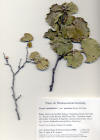|
Cercis canadensis
var.
mexicana |
|
|
Trees and Shrubs of Kern County (Jan 2013) Cercis. Deciduous shrubs or trees with alternate heart-shaped leaves; flowers in umbellate clusters on spurt shoots or branches, appearing before the leaves; fruit flat, bean-like, dehiscent. 10 species, northern hemisphere, 1 in California. Cercis occidentalis Torrey ex A. Gray 1850. Western red bud. Deciduous shrub or tree, easily recognized by the red flowers that appear in the spring before the leaves; leaves round but lobed at base, veins conspicuous. Widely distributed in western U.S. to Texas and Mexico. Type from rocky drains of the Upper Guadeloupe, Texas. Kern Co.: Occasional in canyons east of the valley, 609–1,006 m. Bark astringent, used as a remedy for diarrhea and dysentery (Krochmal et al. 1954). Pharmacological References Kaiser J., M. Yassin, S. Prakash, N. Safi, M. Agami, S. Lauw, E. Ostrozhenkova, A. Bacher, F. Rohdich, W. Eisenreich, J. Safi and A. Golan-Goldhirsh. 2007. Anti-malarial drug targets: screening for inhibitors of 2C-methyl-D-erythritol 4-phosphate synthase (IspC protein) in Mediterranean plants. Phytomedicine 14(4): 242–249. “The recently discovered non-mevalonate pathway of isoprenoid biosynthesis serves as the unique source of terpenoids in numerous pathogenic eubacteria and in apicoplast-type protozoa, most notably Plasmodium, but is absent in mammalian cells. It is therefore an attractive target for anti-infective chemotherapy. The first committed step of the non-mevalonate pathway is catalyzed by 2C-methyl-D-erythritol 4-phosphate synthase (IspC). Using photometric and NMR spectroscopic assays, we screened extracts of Mediterranean plants for inhibitors of the enzyme. Strongest inhibitory activity was found in leaf extracts of Cercis siliquastrum.”
Salatino A, M. L.
Salatino and D. E. Giannasi. 2000. Flavonoids and the taxonomy of
Cercis. |
|


